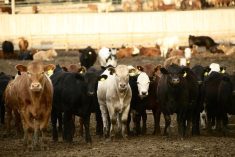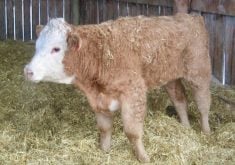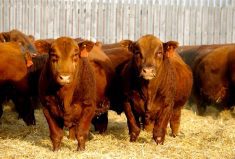Shipping fever caused by Mannheimia haemolytica is the most important respiratory disease of cattle in North America, particularly in feedlot animals that have been through the stressful marketing and assembly processes (Pathological Basis of Veterinary Disease). M. haemolytica biotype A, serotype 1 is the etiologic agent most commonly responsible for severe pulmonary lesions. Some investigators still consider Pasteurella multocida and other serotypes of M. haemolytica important pathogens in the mix of bacteria and viruses causing pneumonia.
M. haemolytica pneumonia is common in feedlot calves. An adult cow dying suddenly of pneumonia caused by this pathogen has been considered unusual. Dr. John Campbell, director of the disease investigation unit at the University of Saskatchewan’s Western College of Veterinary Medicine, recently identified two separate incidents of adult cows dying unexpectedly from pneumonia caused by M. haemolytica. One outbreak occurred in a beef herd, the second in a herd of mature dairy cows.
Campbell reported that it’s unusual for adult cows to die suddenly of a pneumonia caused by this pathogen. While there have been a few cases over the years, it may have been happening more this year. “I have spoken to several other veterinarians in the western provinces who have recently dealt with similar outbreaks,” he added.
It’s important to understand that M. haemolytica can be found occasionally in the nasal passages of normal cattle. It often takes some other stressor, such as a viral infection, to create an environment that allows this bacterium to flourish and establish an infection in the lungs.
Bovine respiratory disease generally develops within a mix of bacterial and viral infections. In addition, other stressors are important in the development of respiratory disease. Risk factors in calves include weaning stress, transport, mixing of calves from various sources, exposure to dust, inclement weather and insufficient immunity in the presence of pathogens associated with respiratory disease. Added risk factors are often not present in the appearance of pneumonia in adult cows.
Campbell goes on to say, “What has perplexed us in some of these latest outbreaks is that none of these other risk factors seem to be obviously present. We are still working on the investigations, but to date, we haven’t been able to identify any previous viral infections in these animals.”
A six-year study (2013 to 2019) in France looked carefully at necropsy outcomes and etiologies (cause of disease). The study placed particular emphasis on fatal respiratory diseases in adult cattle. The study set out to assess the importance of respiratory diseases as a cause of death in adult cattle, plus describe associated lesions and characterize associated pathogens causing respiratory diseases.
In young cattle, bovine respiratory disease (BRD) is a major cause of death and M. haemolytica is a frequent pathogen. Knowledge of fatal BRD in adult cattle is more limited. Investigators assessed the importance of infectious BRD as a cause of death in adult cattle and determined the associated pathogens. They analyzed data from 737 adult cattle necropsies at Oniris Nantes, France, over six years. Each carcass was subjected to a complete necropsy. The study showed respiratory diseases are the second leading cause of death in adult cattle after digestive disorders. Among necropsy findings, the study showed a strong predominance of infectious lung lesions characterized by fibrinous, hemorrhagic and/or necrotic bronchopneumonia — changes characteristic of M. haemolytica. The study concluded that M. haemolytica should be included in the differential diagnosis of BRD in adult cattle. A Scottish investigation about the same time drew similar conclusions.
Leukotoxin and lipopolysaccharides are virulence factors generated by M. haemolytica. The combination of the two toxins in the throes of acute infection is described as “the lips that deliver the kiss of death” (Merck). M. haemolytica could be considered among respiratory pathogens that have reached the apex of evolution, being able to co-operate with other microbes to use the innate immune response against its host by promoting destruction of neutrophils and macrophages (cells typically used to defend against infection).
The good news is that in most reported cases, the identified strain of M. haemolytica bacteria appeared susceptible to most antibiotics. Other cows identified with pneumonia in the early stages were successfully treated with antibiotic therapy.
Lessons learned to date:
- Though relatively uncommon, pneumonia caused by M. haemolytica should be included in the differential of sudden deaths in adult cows.
- Having your veterinarian examine a severely sick cow or having them perform a post-mortem on a cow could help with a proper diagnosis before the problem gets out of hand.
- Lesions of M. haemolytica pneumonia are easy to identify in a post-mortem because the pleura of the lungs are covered with yellow fibrin and the anterior lung tissue is often dark red or purple and firm to the touch.
- There is little doubt that bacteria are passed from animal to animal. A form of bovine social distancing might be useful to control spread.
- To ensure optimal immunity, pay attention to proper nutrition and trace mineral levels. Consider a M. haemolytica vaccine in adult cow herds. In a western Canadian study of vaccine use in cow-calf herds conducted as part of the western Canadian cow-calf surveillance study, Dr. Cheryl Waldner and colleagues reported that only four per cent of cow-calf producers were using MH vaccines in their adult cows. Vaccination against common viral pathogens such as IBR, BVD and BRSV is routinely done in many herds.
- Consult with your veterinarian about potential issues and existing vaccination protocols.

















